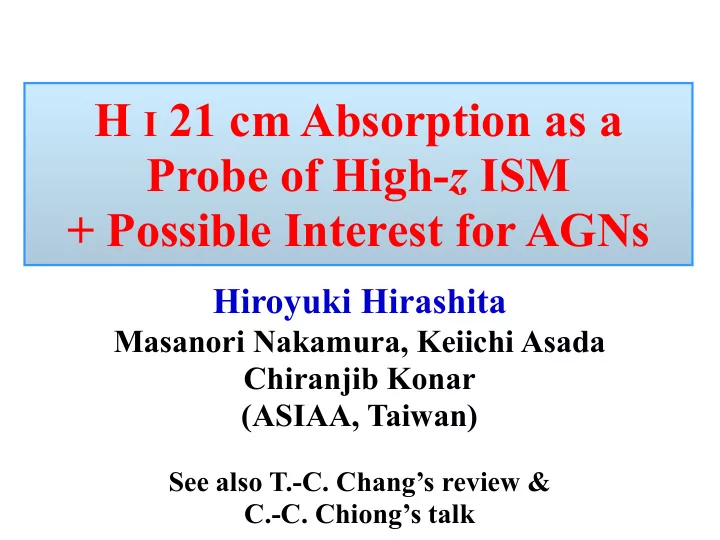

H I 21 cm Absorption as a Probe of High- z ISM + Possible Interest for AGNs Hiroyuki Hirashita Masanori Nakamura, Keiichi Asada Chiranjib Konar (ASIAA, Taiwan) See also T.-C. Chang’s review & C.-C. Chiong’s talk
Outline 1. Introduction to DLAs 2. Physical State of the ISM in DLAs 3. Interests in AGNs at ASIAA 4. Summary
1. Introduction to Damped Ly α Clouds (DLAs) Damped Ly α cloud QSO Ly α absorption • High H I column density (> 2 × 10 20 cm –2 ) Reservoir of a large amount of H I ⇒ progenitors of nearby large galaxies? • Unique objects at high z for detailed study ISM by using various species.
21 cm Observations of DLAs Srianand et al. (2012) • detection rate: 1/10 see also Curran et al. (2010) Kanekar et al. (2009): anticorrelation between metallicity and T s
H 2 in DLAs (A Probe of Cold Gas) Ledoux, Petitjean, & Srianand (2003) log (molecular fraction) log (molecular fraction) large dispersion Paucity of H 2 metal depletion log (dust/gas)
DLA Samples are mostly tracing diffuse medium? Paucity of 21 cm absorption detection ⇒ low τ ⇒ High T s (warm diffuse medium) Paucity of H 2 absorption detection ⇒ H is mostly atomic in the warm diffuse medium. (Hirashita et al. 2003)
2. Physical State of the ISM in DLAs Hirashita et al. (2003) Damped Lyman α clouds (DLAs): N H > 2 × 10 20 cm –2 background quasar Experiment: One simulated galaxy with a background quasar at a random line of sight
Patchy and localized H 2 distribution Distribution of H 2 Hirashita et al. (2003) log (molecular fraction) Equilibrium H 2 abundance (1) Formation on dust (2) Destruction by UV 50 pc (1) = (2) with i 21 = 0.1, D = 0.1 D sun
increases rapidly at “Simulation” of Observation (←self-shielding) Choose randomly a line of sight on the simulated galaxy ... Hirashita & Ferrara (2005) positive correlation log (molecular fraction) Molecular fraction log ( D / D sun ) ~ ‒1.5 large scatter × : Ledoux et al. (2003) ◆ : our simulation log (dust-to-gas ratio)
Implication for 21 cm Observations At least an order of magnitude better S/N ⇒ SKA is suitable. Srianand et al. (2012) • Detection rate of 21 cm absorption is low (1/10). Consistent with the small covering fraction of cold gas • Low detection rate of H 2 , which is localized in the cold medium.
3. Interests in AGNs at ASIAA
Imaging Re-collimation Process of the M87 jet Asada & Nakamura (2012) HST-1 expansion Re-ex pansion Re-collimation? Dynamic Range of current our EVN image is ~ 2500 ‣ SKA will improve it > 1,000,000 - Is the M87 jet re-collimated to form HST-1?
Imaging the counter-jets Asada et al. Detection of the counter-jets is very important; - Constraining a proper viewing angle Jet acceleration dynamics SED analysis for core emission profile Modeling the accretion disk and BH shadow
Diffuse emission around FR II radio galaxies: episodic activity α inn inj ∼ α out inj : similar jet power (Konar & Hardcastle, 2013) Newly discovered diffuse halo (Sirothia+, 2013) Hope to discover many such radio haloes with the SKA Radio Galaxies: Their Dynamics and Episodic Jet Activities – p.17/17
4. Summary (1)Small science group in ASIAA. ⇒ Collaboration is necessary. (2)Paucity of H I 21 cm detection for DLAs can be understood in terms of the prominent warm diffuse medium, consistent with the small H 2 detection rate. (3)AGN science in ASIAA a. Collimation and dynamics of the M87 jet b. Survey of diffuse radio emission around radio galaxies
Deadline for abstracts: 24 August 2013
Recommend
More recommend